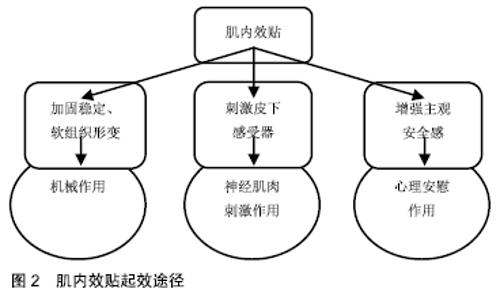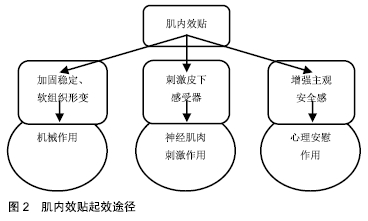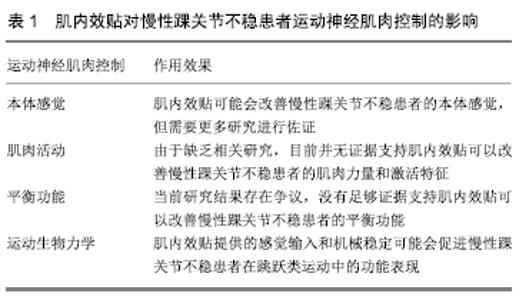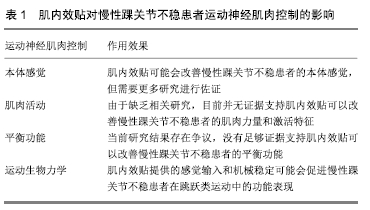Chinese Journal of Tissue Engineering Research ›› 2020, Vol. 24 ›› Issue (11): 1783-1789.doi: 10.3969/j.issn.2095-4344.2482
Previous Articles Next Articles
Effects of kinesio taping on motor neuromuscular control in chronic ankle instability
Yin Lulu, Wang Lin
- Kinesiology School, Shanghai University of Sport, Shanghai 200438, China
-
Received:2019-07-12Revised:2019-07-13Accepted:2019-08-09Online:2020-04-18Published:2020-02-29 -
Contact:Wang Lin, Professor, Doctoral supervisor, Kinesiology School, Shanghai University of Sport, Shanghai 200438, China -
About author:Yin Lulu, Master candidate, Kinesiology School, Shanghai University of Sport, Shanghai 200438, China -
Supported by:the National Natural Science Foundation of China, No. 11572202
CLC Number:
Cite this article
Yin Lulu, Wang Lin. Effects of kinesio taping on motor neuromuscular control in chronic ankle instability[J]. Chinese Journal of Tissue Engineering Research, 2020, 24(11): 1783-1789.
share this article

慢性踝关节不稳患者距腓前韧带和跟腓韧带厚度减小,排列紊乱[8],愈合后形成的瘢痕组织降低韧带弹性,削弱韧带对肌肉骨骼的稳定作用,踝关节动力系统的功效下降,进而引起机体一系列运动神经肌肉控制功能的改变[3]。目前对于慢性踝关节不稳的治疗方式主要为神经肌肉训练,包括肌力、本体感觉、平衡协调训练,结合护具、贴扎、矫形器等支撑性治疗[4,9-10]。肌内效贴由于具有弹性,可在维持踝关节稳定性的同时不妨碍其灵活性,近年来在慢性踝关节不稳的防护与治疗的应用中已日益普遍。目前肌内效贴对慢性踝关节不稳患者运动神经肌肉控制的研究重点主要集中于本体感觉、肌肉活动、平衡表现和运动生物力学方面[11]。 2.1 肌内效贴 2.1.1 功能作用 结合现有研究,肌内效贴可能的功能作用主要包括:肌内效贴在适度拉力和患者合适摆位下于体表形成的褶皱可能会增加皮下组织间隙[12],从而改善血液和淋巴循环,改善肿胀;肌内效贴的弹性回缩力可能会增加感觉输入,改善本体感觉[13];感觉输入的增加可能同时会抑制疼痛信号的传导,缓解疼痛[14];此外,肌内效贴可能会改变肌肉对线,根据肌肉起止点选择不同的贴扎方向,可能会促进或抑制肌肉收缩功能[15]。 2.1.2 起效机制 对肌内效贴起效机制的探讨是目前的研究热点,结合现有研究归纳分析,肌内效贴起效途径主要包含3个层面:机械作用;神经肌肉刺激作用;心理安慰作用(图2)。由于自身贴布的属性,肌内效贴贴扎后可以增强组织解剖构造的稳定度,同时,肌内效贴自身弹性回缩力会引起皮下软组织的形变,可能会增大皮下间隙,促进消肿,缓解疼痛。综上,加固稳定和软组织形变构成了肌内效贴起效途径的机械作用。早在2015年PAMUK等[16]使用MRI证实肌内效贴作用于胫骨前肌会引起整个小腿的异质性形变,随后CIMINO等[17]测量50%肌内效贴拉力时脊柱在不同姿势下的皮层厚度,结果发现在贴布末端表皮厚度减小。同样,近期WANG等[6]也在磁共振弹性成像中发现肌内效贴可以降低浅层椎旁肌的剪切刚度,由此可见,肌内效贴可引起表层组织形变为其起效机制提供了理论基础。 "


与机械作用并行,由于自身的弹性回缩力对皮下组织产生牵拉,肌内效贴可能会刺激牵张刺激感受器和压力刺激感受器,增加感觉输入,增加运动神经元兴奋性,进而从神经肌肉刺激层面对运动进行调控[15]。KONISHI[18]发现肌内效贴的触觉刺激可以减轻因Ia传入活动衰减引起的肌无力。然而TREMBLAY等[19]使用经颅磁证明肌内效贴产生的刺激不足以改变皮质脊髓兴奋性,其他研究也发现肌内效贴不会影响下肢肌肉的H反射,调节运动神经元兴奋性[15]。由于当前研究尚少,肌内效贴的神经肌肉刺激作用尚不明朗,未来需要更多机制类研究进行深入探讨。 此外,部分研究认为,肌内效贴提供的支撑稳定会提高慢性踝关节不稳患者主观的安全感和稳定度,从心理层面促进运动表现[20]。因此,心理安慰作用也应被纳入肌内效贴起效机制的考虑范畴。 2.2 肌内效贴对慢性踝关节不稳患者运动神经肌肉控制的影响 见表1。 "


2.2.1 肌内效贴对慢性踝关节不稳本体感觉的影响 由于慢性踝关节不稳患者韧带和皮下感受器损伤,二者的张力-压缩关系被破坏[21],混淆了中枢神经系统对关节位置及运动信息的感觉传入,可能造成患侧踝关节本体感觉减弱[22]。本体感觉主要包括关节位置觉、力觉和运动觉:关节位置觉是评估关节被动定位及定位后重现关节位置的能力[23],研究发现慢性踝关节不稳患者在踝关节跖屈合并内翻时的位置觉误差要显著大于健康人[22,24];力觉是机体对肌肉力量和张力的感知[25],前人研究表明,由于慢性踝关节不稳患者的高尔基腱器官对肌肉张力的感知下降,其力觉要低于健康人[22,26];运动觉通常是在缓慢的角速度下检测出关节的被动运动阈值[27],SOUSA等[26]发现1(°)/s下慢性踝关节不稳患者患侧的内翻运动觉要低于健侧和健康对照组。综上可知,相比健康人,慢性踝关节不稳患者患侧踝关节的位置觉、运动觉和力觉均减弱,这会影响其对自身运动信息的判断和处理,将自身置于再次扭伤的高风险中[28]。 肌内效贴弹性回缩力对皮下感受器的刺激会增加感觉传入,可能会从神经肌肉刺激层面改善慢性踝关节不稳患者的本体感觉。目前探讨肌内效贴对慢性踝关节不稳人群本体感觉影响的相关研究较少,只能结合肌内效贴对于健康人踝关节本体感觉的相关研究进行讨论。HALSETH等[29]对健康人进行跖屈及跖屈20°下内翻的关节位置重现测试,结果发现肌内效贴并没有改善关节位置觉。BAILEY等[30]同样发现肌内效贴不能改善健康人踝关节的本体感觉控制,作者认为健康人不存在踝关节本体感觉缺陷,肌内效贴对其本体感觉改善作用并不明显。在此基础上,LONG等[31]研究将健康人按照其本体感觉划分后发现,肌内效贴可改善本体感觉较差人群的踝关节本体感觉,但对于本体感觉较好人群反而造成过度感觉负荷,影响其正常本体感觉表现,这提示本体感觉较差人群或许能从肌内效贴受益。而将应用人群定位到慢性踝关节不稳患者,目前研究尚少。SIMON等[13]研究表明肌内效贴可显著减少慢性踝关节不稳患者外翻时的力觉误差,在贴扎72 h后,力觉甚至接近健康人水平。结合上述研究发现,慢性踝关节不稳患者感受器受损,对肌内效贴拉力刺激的敏感性较高,肌内效贴可能会通过增加感觉输入来改善慢性踝关节不稳患者踝关节的本体感觉,但还需要更多高质量研究佐证。 2.2.2 肌内效贴对慢性踝关节不稳肌肉活动的影响 研究发现,在等速肌力测试中,慢性踝关节不稳患者踝关节内翻、外翻肌群的峰力矩下降[32-33],同时,近端髋关节伸展、外展肌群的峰力矩也会下降,上述改变会影响慢性踝关节不稳患者运动的敏捷性和爆发力[34]。目前肌内效贴改善肌力的相关生理机制一直未被证实,尚处于推论阶段:肌内效贴通过对真皮层Ⅱ型机械性感受器的刺激,影响肌梭和高尔基腱器官对肌肉长度和张力的调节,进而募集更多运动单位来改善肌力[35]。对此,部分研究认为肌内效贴可以增强下肢主动肌的肌肉力 量[36-37],但也有研究持否定结论[38-40],而目前探讨肌内效贴对踝周肌群力量的相关研究且多集中于健康人。CSAPO等[41]研究发现,肌内效贴可以增强腓肠肌内外侧头的肌肉力量和积分肌电。而与之相反,GóMEZ-SORIANO等[42]认为肌内效贴虽能增加腓肠肌内侧头的肌电图活动,但其效力并不足以改善肌力、肌张力和柔韧性。CSAPO等[35]Meta分析同样表明,当前证据不支持肌内效贴增强健康人踝跖屈肌群肌力。近期一篇Meta分析也阐明,肌内效贴不能改善健康人下肢肌肉力量,但可能会促进肌骨疾病患者的肌力表现[43],而目前尚缺乏研究探讨肌内效贴对慢性踝关节不稳患者下肢肌肉力量表现,因此并无证据支持肌内效贴可以改善慢性踝关节不稳患者的肌肉力量。 另外,由于慢性踝关节不稳患者踝足稳定性下降,踝周肌肉兴奋性降低,慢性踝关节不稳患者会调整运动策略以代偿踝关节“弱链”的不足,故活动时下肢肌肉激活的时相性和活化程度会发生相应改变。在步行时,有研究发现慢性踝关节不稳患者髋膝踝的肌肉激活时间提前,腓骨长肌在整个步态周期中激活时间增加[44]。在急跑停跳活动中,慢性踝关节不稳患者在落地前期胫骨前肌和腓肠肌外侧头的肌肉协同收缩下降[45],在模拟外踝扭伤测试时,慢性踝关节不稳患者胫骨前肌和比目鱼肌反应时间延后[46],上述肌肉激活强度和时序的改变都反映了下肢的适应与代偿。FAYSON等[47]发现健康人肌内效贴贴扎后在跳深运动时,胫骨前肌和腓骨长肌的平均肌电图活动下降,MARTINEZ-GRAMAGE等[48]同样发现健康人小腿肌内效贴贴扎72 h后在步行的支撑相腓肠肌外侧头激活延迟,活动时长缩短。与之类似,BRIEM等[49]在踝关节内翻干扰前500 ms至干扰后1 500 ms内,比较肌内效贴,运动白贴和不贴下男性运动员腓骨长肌的平均RMS、峰值RMS及到达峰值RMS的时间,结果表明肌内效贴与不贴并无差异,不及运动白贴的稳定作用。上述研究表明,肌内效贴对健康人踝周肌肉激活可能存在抑制作用,这可能是由于肌内效贴持续的拉力刺激下感受器发生适应,运动神经的兴奋性下降所致,而慢性踝关节不稳患者韧带的感受器损伤,踝稳定性下降,由于缺乏相关研究,关于肌内效贴提供的稳定和刺激是否可以改善慢性踝关节不稳患者的肌肉激活等特征仍需深入探讨。 2.2.3 肌内效贴对慢性踝关节不稳平衡功能的影响 平衡功能有赖于躯体本体感觉、视觉、前庭觉3个系统的协调配合,属于较复杂的神经肌肉控制,慢性踝关节不稳患者本体感觉、肌肉活动的改变都会影响平衡功能的表现。在静态平衡测试中,WIKSTROM等[50]发现单腿睁眼站立时,慢性踝关节不稳患者的压力中心摆动速度在内外向和前后向均显著大于健康人,在单腿闭眼站立时,慢性踝关节不稳患者表现出更为明显的平衡功能缺陷[51]。在动态平衡方面,研究发现在星形伸展平衡测试(star excursion balance test,SEBT)测试中慢性踝关节不稳患者在前向、后内向和后外向到达的最远距离都低于健康人[52-53]。HOCH等[54]通过运动学分析发现慢性踝关节不稳患者在SEBT测试中,伴随髋内收和踝外翻,躯干向支撑腿的倾斜增大,在维持重心稳定过程中踝策略向髋策略的转变反映了人体运动功效的降低,上述一系列姿势策略功效的下降都可能增加慢性踝关节不稳患者再次扭伤的风险[55]。 近期ANDREO等[56]分析健康人在Y平衡测试中身体重心的三维空间分布后,发现肌内效贴和白贴都可以增加身体重心轨迹的复杂性,这有助于动态平衡的维持,其他研究也表明肌内效贴可以改善健康人的平衡功能[57],但将其应用人群定位到慢性踝关节不稳人群时,肌内效贴对慢性踝关节不稳患者动态平衡功能的改善作用尚存在争议。JACKSON等[58]使用平衡误差得分系统展开肌内效贴对于慢性踝关节不稳人群平衡的对照研究,结果发现与贴扎前相比,肌内效贴组平衡功能显著改善,LEE等[59]也发现在慢性踝关节不稳足球运动员进行贴扎时,肌内效贴组SEBT测试表现显著高于安慰贴组与不贴组。上述研究都支持肌内效贴对慢性踝关节不稳患者平衡功能的改善作用。然而与之相反,BICICI等[60]发现,肌内效贴对慢性踝关节不稳篮球运动员SEBT测试表现并无显著改善作用,SHIELDS等[61]同样发现肌内效贴干预前后慢性踝关节不稳患者的COP摆动和稳定时间不存在显著性差异。DE-LA-TORRE-DOMINGO等[20]使用NeuroCom平衡仪对慢性踝关节不稳患者进行肌内效贴干预后发现,肌内效贴组与不贴组的感觉统合测试得分无差异,作者将其原因归结为受试者主观安全感的增加。综上,由于不同研究贴扎方法和测试方法异质性较大,肌内效贴对慢性踝关节不稳患者平衡功能的相关研究存在很大争议,目前证据尚不支持肌内效贴可以改善慢性踝关节不稳患者的平衡功能,未来需要实验设计更加严谨、贴扎统一规范的研究来进一步论证。 2.2.4 肌内效贴对慢性踝关节不稳运动生物力学的影响 研究发现,在步行和跑步时,慢性踝关节不稳患者胫骨内旋增加,踝关节跖骨高度下降,跟骨内翻、跖屈角度增加[62],垂直地面反作用力和负荷率增加[63],足底压力中心外移[64],髋踝的协调度也会下降[65]。在单腿跳跃落地时,相比健康对照组,慢性踝关节不稳患者落地前髋关节的屈曲角度和关节刚度较大[66]。上述生物力学的改变表明在步行、跑步及较复杂功能活动中,慢性踝关节不稳患者由于踝关节稳定性和神经肌肉调控能力下降,进而采取“保护性”策略降低自身灵活性,此时踝关节处于较僵硬的状态,从而代偿性动员髋关节进行能量吸收和策略调整,但这可能增加踝关节再次扭伤及退化的风险[66]。 目前研究表明,肌内效贴对健康人运动时的功能表现和运动学动力学特征无明显改善作用。CSAPO等[41]对健康人的小腿三头肌贴扎进行跳深测试,结果发现贴扎前后跳深高度和反应强度指数不存在显著性差异。BOOZARI等[67]同样发现在排球运动员疲劳前后,肌内效贴对运动员下蹲跳的高度和垂直刚度都没有显著改善。但上述研究结果仅限于健康人,而对于肌骨疾病患者,近期Meta分析已指出,在跳跃类运动中,肌内效贴提高踝关节的稳定性和功能表现的作用要优于白贴[43,68]。BICICI等[60]发现肌内效贴对于慢性踝关节不稳篮球运动员纵跳,单腿站立提踵等活动中,肌内效贴由于对踝关节无限制作用,其对运动表现的影响要优于运动白贴。HUANG等[69]研究也表明肌内效贴增加了垂直纵跳时腓肠肌内侧头肌电图和垂直地面反作用力,运动表现促进作用要优于运动白贴。可见,肌内效贴提供的感觉输入和机械稳定可能会促进慢性踝关节不稳患者在跳跃类运动中的功能表现。 "

| [1] DOHERTY C, DELAHUNT E, CAULFIELD B, et al.The incidence and prevalence of ankle sprain injury: a systematic review and meta-analysis of prospective epidemiological studies.Sports Med. 2014;44 (1): 123-140. [2] GRIBBLE PA, DELAHUNT E, BLEAKLEY CM, et al.Selection criteria for patients with chronic ankle instability in controlled research: a position statement of the International Ankle Consortium.J Athl Train.2014;49(1):121-127. [3] VUURBERG G, HOORNTJE A, WINK LM, et al.Diagnosis, treatment and prevention of ankle sprains: update of an evidence- based clinical guideline.Br J Sports Med.2018;52(15):956. [4] DOHERTY C, BLEAKLEY C, DELAHUNT E, et al. Treatment and prevention of acute and recurrent ankle sprain: an overview of systematic reviews with meta-analysis.Br J Sports Med.2017;51 (2): 113-125. [5] KASE K, WALLIS J, KASE T.Clinical therapeutic applications of the kinesio taping method. 2nd ed. Tokyo: Ken Ikai Co.Ltd.2003. [6] WANG CK, FANG YD, LIN LC, et al. Magnetic Resonance Elastography in the Assessment of Acute Effects of Kinesio Taping on Lumbar Paraspinal Muscles.J Magn Reson Imaging. 2018;49(4):1039-1045. [7] YEUNG SS, YEUNG EW. Acute Effects of Kinesio Taping on Knee Extensor Peak Torque and Stretch Reflex in Healthy Adults. Medicine (Baltimore).2016; 95 (4): e2615. [8] JUNG HG, KIM NR, KIM TH, et al. Magnetic Resonance Imaging and Stress Radiography in Chronic Lateral Ankle Instability.Foot Ankle Int.2017;38(6):621-626. [9] 覃华生,潘玮敏,李然,等.慢性踝关节不稳的运动康复:研究现状与特点[J].中国组织工程研究,2018,22(36):5865-5871. [10] KOSIK KB, MCCANN RS,TERADA M, et al. Therapeutic interventions for improving self-reported function in patients with chronic ankle instability: a systematic review.Br J Sports Med.2017;51 (2): 105-112. [11] 罗炯,郑兵,解浩东.肌内效贴扎对足踝生物力学特征影响的理论研究与应用进展[J].中国组织工程研究, 2017,21(28):4570-4576. [12] 余波,祁奇,陈文华,等.不同贴扎方式肌内效贴的回缩力特征及其改变皮下间隙的临床研究[J].中国康复医学杂志, 2016,31(3): 296-300. [13] SIMON J, GARCIA W, DOCHERTY CL.The effect of kinesio tape on force sense in people with functional ankle instability.Clin J Sport Med.2014;24 (4): 289-294. [14] RAHLF AL, BRAUMANN KM, ZECH A.Kinesio taping improves perceptions of pain and function of patients with knee osteoarthritis. a randomized, controlled trial.J Sport Rehabil.2018; 28(5):481-487. [15] YOOSEFINEJAD AK, MOTEALLEH A, ABBASALIPUR S, et al. Can inhibitory and facilitatory kinesiotaping techniques affect motor neuron excitability? A randomized cross-over trial.J Bodyw Mov Ther.2017; 21 (2): 234-239. [16] PAMUK U, YUCESOY CA.MRI analyses show that kinesio taping affects much more than just the targeted superficial tissues and causes heterogeneous deformations within the whole limb.J Biomech. 2015;48(16):4262-4270. [17] CIMINO SR, BEAUDETTE SM, BROWN SHM. Kinesio taping influences the mechanical behaviour of the skin of the low back: A possible pathway for functionally relevant effects.J Biomech.2018; 67:150-156. [18] KONISHI Y.Tactile stimulation with kinesiology tape alleviates muscle weakness attributable to attenuation of Ia afferents.J Sci Med Sport.2013;16(1):45-48. [19] TREMBLAY F, KARAM S.Kinesio-Taping Application and Corticospinal Excitability at the Ankle Joint.J Athl Train.2015;50 (8): 840-846. [20] DE-LA-TORRE-DOMINGO C, ALGUACIL-DIEGO I M, MOLINA-RUEDA F, et al. Effect of kinesiology tape on measurements of balance in subjects with chronic ankle instability: a randomized controlled trial.Arch Phys Med Rehabil.2015;96 (12): 2169-2175. [21] WU X, SONG W, ZHENG C, et al.Morphological study of mechanoreceptors in collateral ligaments of the ankle joint.J Orthop Surg Res.2015;10:92. [22] HAGEN M, LEMKE M, LAHNER M. Deficits in subtalar pronation and supination proprioception in subjects with chronic ankle instability.Hum Mov Sci.2018;57:324-331. [23] BOYLE J, NEGUS V.Joint position sense in the recurrently sprained ankle.Aust J Physiother.1998; 44 (3): 159-163. [24] YOKOYAMA S,MATSUSAKA N,GAMADA K, et al. Position- specific deficit of joint position sense in ankles with chronic functional instability.J Sports Sci Med.2008;7(4):480-485. [25] ARNOLD BL, DOCHERTY CL.Low-load eversion force sense, self-reported ankle instability, and frequency of giving way.J Athl Train.2006;41(3):233-238. [26] SOUSA ASP, LEITE J, COSTA B, et al.Bilateral Proprioceptive Evaluation in Individuals With Unilateral Chronic Ankle Instability.J Athl Train.2017;52(4):360-367. [27] KONRADSEN L. Factors Contributing to Chronic Ankle Instability: Kinesthesia and Joint Position Sense.J Athl Train.2002;37(4): 381-385. [28] HERTEL J.Sensorimotor deficits with ankle sprains and chronic ankle instability.Clin Sports Med.2008;27(3):353-370. [29] HALSETH T, MCCHESNEY J, DEBELISO M, et al. The effects of kinesio™ taping on proprioception at the ankle.J Sports Sci Med. 2004;3(1):1-7. [30] BAILEY D, FIRTH P. Does kinesiology taping of the ankles affect proprioceptive control in professional football (soccer) players? Phys Ther Sport.2017;25:94-98. [31] LONG Z, WANG R, HAN J, et al. Optimizing ankle performance when taped: Effects of kinesiology and athletic taping on proprioception in full weight-bearing stance.J Sci Med Sport.2017; 20(3):236-240. [32] WISTHOFF B,MATHENY S,STRUMINGER A, et al. Ankle Strength Deficits in a Cohort of Collegiate Athletes with Chronic Ankle Instability.J Sport Rehabil.2019;19:1-6. [33] MUNN J,BEARD DJ,REFSHAUGE KM, et al. Eccentric muscle strength in functional ankle instability. [J]Med Sci Sports Exerc.2003;35 (2): 245-250. [34] MCCANN RS,BOLDING BA,TERADA M,et al.Isometric Hip Strength and Dynamic Stability of Individuals With Chronic Ankle Instability.J Athl Train.2018;53 (7): 672-678. [35] CSAPO R,ALEGRE LM. Effects of kinesio (R) taping on skeletal muscle strength-a meta-analysis of current evidence.J Sci Med Sport.2015;18 (4): 450-456. [36] YEUNG SS, YEUNG EW.Acute Effects of Kinesio Taping on Knee Extensor Peak Torque and Stretch Reflex in Healthy Adults. Medicine(Baltimore).2016;95 (4): e2615. [37] KAYA MUTLU E,MUSTAFAOGLU R,BIRINCI T, et al. Does Kinesio Taping of the Knee Improve Pain and Functionality in Patients with Knee Osteoarthritis? Am J Phys Med Rehabil.2017;96 (1): 25-33. [38] LEMOS TV,JUNIOR JRS,SANTOS M, et al.Kinesio Taping effects with different directions and tensions on strength and range of movement of the knee: a randomized controlled trial.Braz J Phys Ther.2018;22 (4): 283-290. [39] LINS CA,BORGES DT,MACEDO LB,et al.Delayed effect of Kinesio Taping on neuromuscular performance, balance, and lower limb function in healthy individuals: a randomized controlled trial. Braz J Phys Ther.2016;20 (3): 231-239. [40] KORMAN P, STRABURZYŃSKA-LUPA A, RUTKOWSKI R, et al.Kinesio taping does not alter quadriceps isokinetic strength and power in healthy nonathletic men: a prospective crossover study.Biomed Res Int,2015:626257. [41] CSAPO R,HERCEG M,ALEGRE LM, et al.Do kinaesthetic tapes affect plantarflexor muscle performance? J Sports Sci.2012;30 (14): 1513-1519. [42] GÓMEZ-SORIANO J,ABIÁN-VICÉN J,APARICIO-GARCÍA C, et al. The effects of Kinesio taping on muscle tone in healthy subjects: A double-blind, placebo-controlled crossover trial.Man Ther.2014;19 (2): 131-136. [43] YAM ML,YANG Z,ZEE BC, et al.Effects of Kinesio tape on lower limb muscle strength, hop test, and vertical jump performances: a meta-analysis.BMC Musculoskelet Disord.2019;20 (1): 212. [44] FEGER MA,DONOVAN L,HART J M, et al.Lower extremity muscle activation in patients with or without chronic ankle instability during walking.J Athl Train.2015;50 (4): 350-357. [45] LIN CF,CHEN CY,LIN CW. Dynamic ankle control in athletes with ankle instability during sports maneuvers.Am J Sports Med.2011;39 (9): 2007-2015. [46] SOUSA ASP,VALENTE I,PINTO A,et al.Short and Medium Latency Responses in Participants With Chronic Ankle Instability.J Athl Train.2018;53 (7): 679-686. [47] FAYSON SD,NEEDLE AR,KAMINSKI TW.The Effect of Ankle Kinesio Tape on Ankle Muscle Activity During a Drop Landing.J Sport Rehabil.2015;24 (4): 391-397. [48] MARTINEZ-GRAMAGE J,MERINO-RAMIREZ MA,AMER-CUENCA JJ,et al.Effect of Kinesio Taping on gastrocnemius activity and ankle range of movement during gait in healthy adults: A randomized controlled trial.Phys Ther Sport.2016;18:56-61. [49] BRIEM K,EYTHÖRSDÖTTIR H,Magnúsdóttir RG,et al.Effects of kinesio tape compared with nonelastic sports tape and the untaped ankle during a sudden inversion perturbation in male athletes.J Orthop Sports Phys Ther.2011;41 (5): 328-335. [50] WIKSTROM EA,FOURNIER KA,MCKEON PO.Postural control differs between those with and without chronic ankle instability.Gait Posture.2010;32 (1): 82-86. [51] TERADA M, BEARD M, CAREY S, et al.nonlinear dynamic measures for evaluating postural control in individuals with and without chronic ankle Instability.Motor Control.2019;23(2): 243-261. [52] DOHERTY C, BLEAKLEY C, HERTEL J, et al.Dynamic balance deficits in individuals with chronic ankle instability compared to ankle sprain copers 1 year after a first-time lateral ankle sprain injury.Knee Surg Sports Traumatol Arthrosc.2016;24(4): 1086-1095. [53] FUSCO A,GIANCOTTI GF,FUCHS PX, et al. Wobble board balance assessment in subjects with chronic ankle instability.Gait Posture.2019;68:352-356. [54] HOCH MC, GAVEN SL, WEINHANDL JT. Kinematic predictors of star excursion balance test performance in individuals with chronic ankle instability.Clin Biomech (Bristol, Avon).2016;35:37-41. [55] HOLMES A, DELAHUNT E.Treatment of common deficits associated with chronic ankle instability.Sports Med.2009;39(3): 207-224. [56] ANDREO P, KHALAF K, HEALE L, et al. Effects of Kinesiology Tape on Non-linear Center of Mass Dispersion During the Y Balance Test.Front Physiol.2018;9:1527. [57] NAKAJIMA MA, BALDRIDGE C.The effect of kinesio tape on vertical jump and dynamic postural control.Int J Sports Phys Ther.2013; 8 (4): 393–406. [58] JACKSON K, SIMON JE, DOCHERTY CL. Extended use of kinesiology tape and balance in participants with chronic ankle instability.J Athl Train.2016;51(1):16-21. [59] LEE BG, LEE JH.Immediate effects of ankle balance taping with kinesiology tape on the dynamic balance of young players with functional ankle instability.Technol Health Care.2015;23(3): 333-341. [60] BICICI S, KARATAS N, BALTACI G. Effect of athletic taping and kinesiotaping on measurements of functional performance in basketball players with chronic inversion ankle sprains.Int J Sports Phys Ther.2012;7 (2): 154-166. [61] SHIELDS CA, NEEDLE AR, ROSE WC, et al.Effect of elastic taping on postural control deficits in subjects with healthy ankles, copers, and individuals with functional ankle instability.Foot Ankle Int.2013;34 (10): 1427-1435. [62] MOISAN G, DESCARREAUX M, CANTIN V. Effects of chronic ankle instability on kinetics, kinematics and muscle activity during walking and running: A systematic review.Gait Posture.2017;52: 381-399. [63] BIGOUETTE J, SIMON J, LIU K, et al. Altered vertical ground reaction forces in participants with chronic ankle instability while running.J Athl Train.2016;51 (9): 682-687. [64] NYSKA M, SHABAT S, SIMKIN A, et al. Dynamic force distribution during level walking under the feet of patients with chronic ankle instability.Br J Sports Med.2003;37(6):495-497. [65] YEN SC, CHUI KK, CORKERY MB, et al.Hip-ankle coordination during gait in individuals with chronic ankle instability.Gait Posture.2017;53:193-200. [66] KIM H, SON SJ, SEELEY MK, et al. Kinetic Compensations due to Chronic Ankle Instability during Landing and Jumping.Med Sci Sports Exerc.2018;50(2):308-317. [67] BOOZARI S, SANJARI MA, AMIRI A, et al. Effect of Gastrocnemius Kinesio Taping on Countermovement Jump Performance and Vertical Stiffness Following Muscle Fatigue.J Sport Rehabil.2018; 27 (4): 306-311. [68] WANG Y, GU Y, CHEN J, et al. Kinesio taping is superior to other taping methods in ankle functional performance improvement: a systematic review and meta-analysis.Clin Rehabil.2018;32 (11): 1472-1481. [69] HUANG CY, HSIEH TH, LU SC, et al.Effect of the Kinesio tape to muscle activity and vertical jump performance in healthy inactive people.Biomed Eng Online.2011;10:70. |
| [1] | Chen Zehua, Ye Xiangling, Chen Weijian, Du Jianping, Liu Wengang, Xu Xuemeng. Effect of pronated foot posture on proprioception and postural stability based on foot posture index [J]. Chinese Journal of Tissue Engineering Research, 2021, 25(9): 1324-1328. |
| [2] | Song Liming, Su Hailong. Muscle force response characteristics of the slipping leg after an unexpected slip [J]. Chinese Journal of Tissue Engineering Research, 2021, 25(8): 1184-1189. |
| [3] | Tan Biao, Zuo Biao, Huang Yong. Evaluation of balance function of unicompartmental and total knee arthroplasties for treating unicompartmental knee osteoarthritis [J]. Chinese Journal of Tissue Engineering Research, 2020, 24(6): 827-832. |
| [4] | Cao Bin, Zuo Yuqiang, Li Cunrui, Kang Weifeng, Yu Haiquan, Su Jingyang. Correlation of parameters of lordosis type cervical spine saggital plane in asymptomatic adults [J]. Chinese Journal of Tissue Engineering Research, 2020, 24(6): 898-902. |
| [5] | Geng Zhizhong, Pei Ziwen, Yan Gongli, Chen Jian. A meta-analysis of kinesio taping in the treatment of delayed onset muscle soreness [J]. Chinese Journal of Tissue Engineering Research, 2020, 24(35): 5733-5740. |
| [6] | Liu Shuai, Sun Qiangsan. ICB orthotic insole can correct balance, walking ability and biological force line of lower limbs in children with spastic diplegia [J]. Chinese Journal of Tissue Engineering Research, 2020, 24(33): 5272-5276. |
| [7] | Zhang Zhaoming, Lin Tianye, Chen Leilei, Yang Peng, Xu Jingli, Chen Zhenqiu, He Wei, Zhang Qingwen. Total knee arthroplasty in the treatment of knee valgus deformity [J]. Chinese Journal of Tissue Engineering Research, 2020, 24(33): 5277-5282. |
| [8] | Cao Bin, Zuo Yuqiang, Du Hanyang, Yu Haiquan, Su Jingyang, Meng Haoyong. Correlation of saggital parameters of cervical and thoracic junction areas in asymptomatic adults [J]. Chinese Journal of Tissue Engineering Research, 2020, 24(33): 5354-5357. |
| [9] | Sun Jian, Fang Chao, Gao Fei, Wei Laifu, Qian Jun. Clinical efficacy and complications of short versus long segments of internal fixation for the treatment of degenerative scoliosis: a meta-analysis [J]. Chinese Journal of Tissue Engineering Research, 2020, 24(3): 438-445. |
| [10] | Chen Zehua, Ye Xiangling, Chen Weijian, Xu Xuemeng. Relationship between proprioception and postural stability of lower limbs in healthy adults [J]. Chinese Journal of Tissue Engineering Research, 2020, 24(29): 4692-4696. |
| [11] | Yan Xianke. Total knee arthroplasty through a midvastus approach reduces postoperative adverse reactions and accelerates functional recovery of the knee [J]. Chinese Journal of Tissue Engineering Research, 2020, 24(21): 3336-3340. |
| [12] | Feng Xinyuan, Bai Lunhao. Significance of preserving anterior cruciate ligament stump for the stability of knee joint [J]. Chinese Journal of Tissue Engineering Research, 2019, 23(4): 525-531. |
| [13] | Zeng Feng, Li Shuzhen. Rotational positioning of femoral prosthesis in total knee arthroplasty [J]. Chinese Journal of Tissue Engineering Research, 2019, 23(36): 5861-5867. |
| [14] | Zhou Jing, Yang Dan, Wei Meng, Huang Caihong, Zhao Yan. Effects of MOTOmed lower limb function trainer on lower limb function in stroke patients with hemiplegia: a Meta-analysis [J]. Chinese Journal of Tissue Engineering Research, 2019, 23(30): 4913-4920. |
| [15] | Zhong Guoyou. Vibration combined with kinesio taping treats delayed-onset muscle soreness [J]. Chinese Journal of Tissue Engineering Research, 2019, 23(27): 4305-4309. |
| Viewed | ||||||
|
Full text |
|
|||||
|
Abstract |
|
|||||